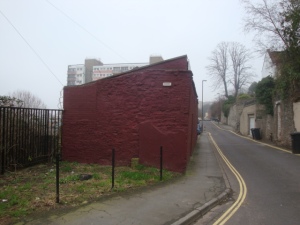It took me a long time to actually take a look at the Dove Street flats. Out of the corner of my eye I had seen them, three 1960s towers poking over the top of the buildings on the west side of Stokes Croft, or catching a glimpse of them down the long staricases and alleyways that run from Kingsdown down the side of Cotham Hill.
It wasn’t utill I tried to find a parking space one day near the Cube cinema that I actually took a trip down and around Dove Street. It was only then that I began to grasp the strange geography of the place. Driving in a loop around the flats, I realised that by car at any rate there is no way onto Cotham Hill, and no way back to Stokes Croft. It reminded me, I am afraid, of the road systems favoured by the architects of apartheid South Africa’s townships. A block of social housing with one route in and out, separated from other residential zones. Dove Street is not a no-go area, nor is it blighted by serious social problems, but is does feel out on a limb and strangely isolated. It certainly seems to miss out on any of the regeneration money that drips into St Paul’s and Stokes Croft, but doesn’t quite make it up the hill.
In the early 1960s Dove Street was home to hundreds of working-class households in a mixture of run-down Victorian and Georgian terracing. If those houses were still there today I expect they would have been long incorporated into Cotham, socially and architecturally. Interestingly, all along the northern edge of the flats, Cotham property owners have managed to get planning permission to cut their generously sized gardens in half and build new properties that face onto Dove Street.
There a mixture of recent and reasonable sympathetic houses and a couple of really nasty 70s and 80s builds in the cheapest blandest brick and it seems, a very large new development on land owned by a very senior judge. There are two pubs too, which according to my guide, are zones of social fraternization between Cotham and Dove Street. Otherwise there isn’t much crossover or through traffic from anywhere. Ok it was very grey February morning but Dove Street feels pretty empty despite the density of life and the closeness of the city centre.
There is, I am afraid to say, little in the council archive on the decision-making behind the Dove Street Flats, though Pevsner notes that the new developments did not actually provide housing at a higher density than the old Victorian terraces. Most of the orignbal occupants were already living on Dove Street and most of those who are still with us, still live on Dove Street. These days the social mix has changed, white working-class folk are sharing the flats with the art house crowd and a big population of newly arrived Somalis. What the flats did provide was housing at a higher elevation and standing on the balcony of Alex Highrise’s flat, twelve stories up, you can see what might have been motivating the City architects department that built them in 1963 and 1964.
The view is sensational, and though one has to look at it through plastic mesh – essential to keeping pigeons out of your place – I saw Bristol anew; familiar landmarks seemed strange suddenly placed in their real geographcical relationship to each other; the strange angles and diagonals of the neighborhood became clear; the vastness of the rotting hulk of Westmorland House was revealed.
The flats themselves are low ceilinged but generously and sensibly proportioned and given that they sit so close to the city centre, very, very reasonably priced – as social housing should be. The exterior finishes of the three towers and the connecting blocks between them are pretty low grade brick and painted concrete, but within the flats one can see something of an era in which standards for social housing were higher: beautifully beveled and varnished internal window frames and good noise insulation. There are new lifts and security systems too, though there are no longer coffin holes: the old lifts had a flap at the back to allow a coffin to descend in the lift horizontally. What happens now? Does one take the stairs or suffer the indignity of a vertical descent?
There are intriguing finds and tiny gems in the urban landscape around the flats. On the north side of Dove Street sits a strange and isolated burgundy- painted outhouse. Lllweyn’s Gears on the north side of King’s Square have created, a hotch potch of a factory on the back of a Georgian terrace. A tiny model spider has sat against a giant retaining wall for over a decade. Small spaces, plaques and walls are used for stickers, picture and tags and a few bigger artworks can be found on hidden walls.
In some ways Dove Street is a world away from Stokes Croft, and according to Alex Highrise, there are some residents who are very happy to keep it that way. Fair enough, but that’s a shame for all of us. It’s a secret corner of the neighborhood worth at the very least a look and stroll; it’s an example of social housing, if not to eveyone’s tastes, that is cheap, decent and in the centre of town; and, it seems to be a retaining wall against the wave of gentrification that threatens, every time the housing market goes mad, to descend from Cotham.






very fine. I’ve never wandered around those flats but have always wanted to. But ‘sensational’ view…? you’ve been in brizzle to long mate..
Too long in bristol? I’ve only Just begun. Not Sensational? not often one gets to view a millenium of urban development from on high…
Intriguing mention of coffins holes, never heard of that before. Liked your thing on R4, David.